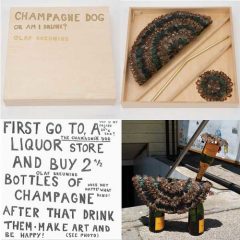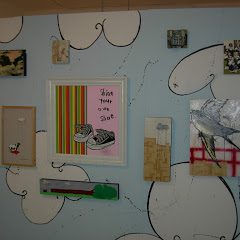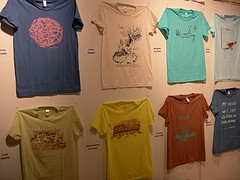Post by Andrea Kirsh
There’s a lot of new stuff out there I’m discovering: some is plastic, others plush or ceramic. And artists are behind all of it. When produced by Cereal Art and distributed at high-end international art fairs, it’s called “Limited edition art.”

Cat Eye Guy by Kenny Scharf, from Cereal Art
Cereal Art is a Philadelphia success story: according to their own publicity, the three-year-old company produces “designs … conceptualized by critically acclaimed internationally recognized contemporary artists who are interested in exploring the possibilities presented by consumer culture.” For $100 you can buy Yoshitomo Nara’s “Pupcup”(TM), a “remarkable kinetic object” 9.5 inches high, made from injection molded and Rotomolded plastic which spins, with the aid of two AA batteries. The same $100 will also buy Kenny Scharf’s “Cateyeguy” (resin, 10 inches high) or, for something useful, Marcel Dzama’s “Sad Ghost Salt and Pepper Shakers” (porcelain, 3 inches), only $75 for the pair. Cereal Artwork can be seen at their own premises in Old City at 149 N 3rd St. or in the lobby of the Institute of Contemporary Art, the Whitney Museum of American Art Store, the Museum of Contemporary Art store (Chicago) and assorted locations in Paris, London, Miami, Las Vegas and elsewhere.

Simone Legno’s Sandy cactus friend
Around South Street one can find a another variant: these go by the name of “toys.” At Jinxed $150 will buy Frank Kozik’s 10 inch vinyl “Knucklebear,” three figures by Dave Kinsey ($50 for the set); $25 will buy Simone Legno’s 5 inch vinyl “Sandy Cactus Friend” in green; the pink version, “Sabochan” is $30.
And the genre, if that’s what it is, has quite a literature. Dot, Dot, Dash; Designer Toys, Action Figures and Character Art (DGV, Berlin, 2006 ISBN-10: 3-89955-161-3) is one of the handsomest and most sophisticated overviews I’ve ever seen of any form of art, decorative art, or collectable. The design (German) is clear and stylish and the printing (Italian) is excellent. Not only does it have 273 pages of luscious color illustrations, but the essays cover everything from the origin of these figures to the technology of their production, the influence of the internet on their distribution, and something of the culture of their collecting. Information on the artist/designers and various series of works is included throughout the book. The scholarly apparatus includes an index of producers’ e-addresses and extraordinarily-detailed photo captions, which often list not only materials and dimensions, but edition sizes and retail prices
The selection is also remarkably international (Japan to Finland, and everywhere in between) and catholic: work derived from graffiti, hip-hop and skateboard cultures, anime and Disney, and a variety work by less commercially-inspired artists, including the Austrian collective Gelatin, the German performance artist and costume-design group Steak Zombies, and Fiona Dalwood, an Australian who makes feminist deconstructions of dolls. Many of the pictured works are cute and some are fuzzy. Some would appeal to children while others are X or at least PG rated.
I’m obviously a late-comer to this body of work. There’s a site with an archive, pictoplasma, which produced a publication as early as 2001. Their current book is Pictoplasma: The Character Encyclopaedia (Pictoplasma Publishing, Berlin, 2006). Interest in this work is not just a German phenomenon; Gingko Press has “Vinyl Will Kill” (2006?), among other titles.
–Andrea Kirsh is an art historian based in Philadelphia. You can read her newest Philadelphia Introductions and other commentary at InLiquid.












